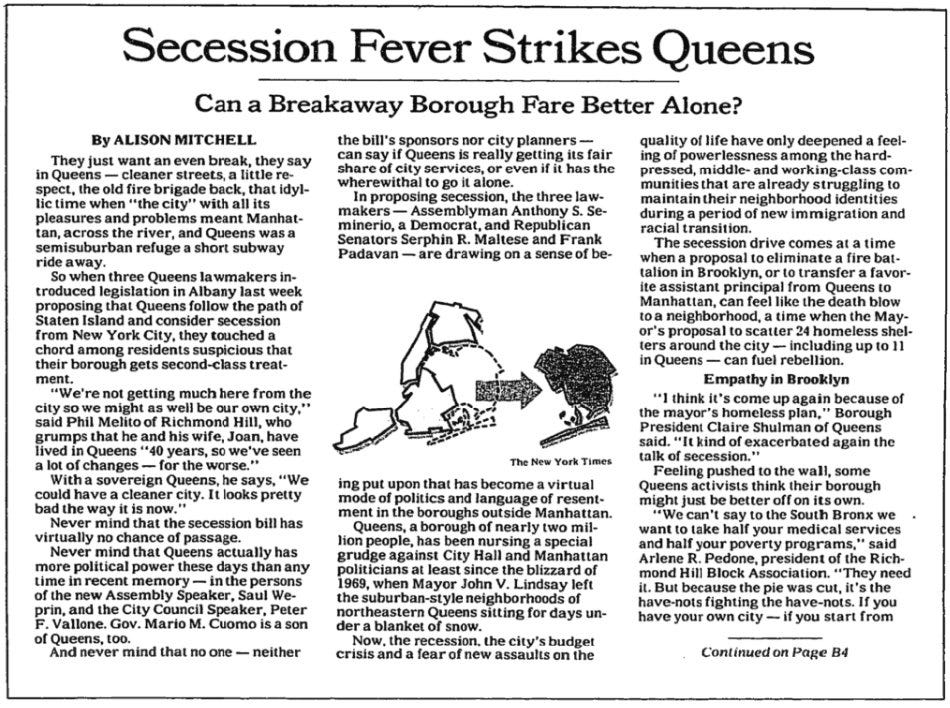When Queens Tried To Secede
From 1910 to 1992, secessionist ideas brewed within the world's borough
After New York City consolidated in 1898, it wasn’t just smooth sailing to the modern day. In fact, it was anything but. The shape and nature of the municipal government, as well as its relationship to the state, continued to evolve.
This is the brief story,1 told through snippets from The New York Times’ archive, about the secession movement in Queens. It began almost immediately after consolidation, and simmered throughout the twentieth century.
It all begins with the Rockaways
The five boroughs came together to form NYC in 1898 (prior to that NYC was just Manhattan and the modern-day Bronx). But almost immediately there were rumblings of discontent and designs for exit. Here, from Queens.

Residents of the Rockaways contended that they weren't getting good results from their taxes, or “taxation without improvement.”
“Perhaps...the city officials do not know the way we are neglected down here.”


By 1914 the secessionist talk in Queens had gotten even louder.

Residents of the Rockaways wanted to leave Queens and form their own county and city. Residents of Jamaica wanted to stay within NYC, but leave Queens and form their own borough. They allied.

These two factions wanted to form a unified front to each get what they wanted—they planned to work with a city charter revision commission, but were prepared to simply pass a bill in Albany over any objection from the city.


Three months later, in March of 1915, a huge delegation of Rockaway residents (plus a brass band) went to Albany to make their case to the state legislature. They began by “[breaking] up a closed call meeting of the Assembly."

Said a Queens resident of the Rockaway peninsula: “We are like a peanut on the ocean and ask you for something to anchor to.”
“The only visits we get from the city authorities are from the tax assessors,” said another. (Naturally, the Board of Estimate was opposed to this.)


“It is a case of a tin can tied to a dog...with the joke on the tin can.”

The New York legislature listened. The 1915 Rockaway City bill passed the state legislature with a healthy majority! What will happen next??
A New York Times editorial quickly derided the 1915 Rockaway City bill. It called the bill “a compound of knavery and stupidity,” and arguments in its favor “plausible and poisonous.”

One of the Rockaway secessionists, Sol Stern, hit back a few days later. He contended that the Rockaways were overcharged for city utilities, and not provided adequate city services.

Mayor Mitchel of New York City brought the debate (temporarily) to a close by vetoing the bill. Secessionist forces could not marshal a state override.

(There is another essay to be had about why the mayor was involved here; the short version is that city and state law work in strange ways you might not expect if you've never looked into it; and they worked differently in 1915 than they do now.)
Mayor Mitchel essentially said to the Rockaways: you cannot afford to leave. The city had invested too much in the area that would have to be paid back, but likely couldn't be, and there was no way the Rockaways could repay their portion of the city's debt.

So the 1915 Rockaway secession attempt failed, and they couldn't muster a state legislative override of the mayor's veto. But they passed another secession bill in 1917! Again, Mayor Mitchel vetoed it. Again, the legislature couldn't override his veto (they were out of session).

The mayor's 1917 veto message was similar to his 1915 message: NYC would lose too much in taxes, the Rockaways couldn't take on their share of city debt, NYC city bonds would look like a bad bet, subway extensions would be hard, and it would require dual control of Jamaica Bay.


Nothing really came of all these Queens secessionists, BUT: “...in April 1992, a bill authorizing a study of the secession of the entire borough of Queens passed the state Senate, but died in committee in the Assembly” (Gibson's New York Legal Research Guide, 4th Ed, p.565).
The Speaker of the Assembly at the time, Saul Weprin, a Democrat from Queens, generally opposed the measure. It was mostly doomed from the start. Also, Staten Island was much further along in the secession process at this time (but that's another essay), and was a test case.


Before the 1992 Queens secession bill died in the state Assembly, the city witnessed some very familiar sentiments: “Alma Young of Laurelton saw secession as a way to stop immigration from Manhattan.”

Secessionist sentiment in Queens mostly ended here, in 1992. But secession is still a live topic in NYC, particularly on Staten Island. I’ll explore that in a later post, but you can find an introduction in the twenty-fifth footnote of my post on NYC’s 1898 consolidation.




I hope stories from old New York becomes a regular series on this newsletter.